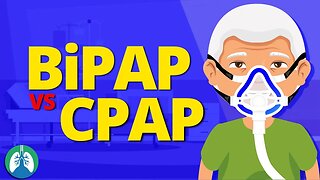Lung Expansion Therapy (OVERVIEW) | Incentive Spirometry | IPPB | CPAP
What is lung expansion therapy? How can it help prevent atelectasis? Watch this video to learn about the different techniques used to help expand the lungs.
💥Lung Expansion Therapy [Full Guide] ➜ ➜ ➜ https://bit.ly/2Lxqeby
➡️ Atelectasis
Atelectasis is a term that refers to a collapse in the alveoli of the lungs. It could be a total collapse of an entire lung or a partial collapse in one or more lobes.
➡️ Causes of Atelectasis
Atelectasis is common in postoperative patients where it can occur during or after the procedure. The reason is that surgery often causes shallow breathing, which results in inadequate airflow to the alveolar region of the lungs.
➡️ Symptoms of Atelectasis
The symptoms of atelectasis will depend on the severity and location of the collapse. In some cases, there may be no symptoms at all. However, in other instances, patients may experience:
- Shortness of breath
- Chest pain
- Wheezing
- Fatigue
- Cyanosis
- Tachypnea
➡️ Lung Expansion Therapy
Lung expansion therapy involves several respiratory care procedures and techniques that are designed to treat atelectasis, pneumonia, acute respiratory failure, and other conditions of the lungs.
➡️ The modalities that can be used in lung expansion therapy include:
- Early patient mobilization
- Deep breathing/directed cough
- Incentive spirometry (IS)
- Continuous positive airway pressure (CPAP)
- Positive airway pressure
- Intermittent positive airway pressure breathing (IPPB)
- High-flow nasal cannula (HFNC)
➡️ Early Patient Mobilization
One of the best ways to prevent atelectasis is through early patient mobilization. This means that patients should be encouraged to get out of bed and move around as soon as possible after surgery.
➡️ Deep Breathing and Directed Coughing
Deep breathing exercises and directed coughing can help treat patients with atelectasis by clearing secretions and recruiting collapsed alveoli.
➡️ Incentive Spirometry
Incentive spirometry (IS) is a technique in which patients use a hand-held device to take sustained maximum inspirations (SMI). The goal is to reach a predetermined volume of air that is initially set by the respiratory therapist.
➡️ Continuous Positive Airway Pressure
Continuous positive airway pressure (CPAP) is a technique in which a machine delivers air through a mask that covers the nose and mouth.
➡️ Positive Airway Pressure
Positive airway pressure (PAP) is a technique in which a device delivers positive pressure to improve lung expansion. It involves the use of PEP, flutter, and CPAP. PEP and flutter can be used for airway clearance therapy.
➡️ Intermittent Positive Pressure Breathing (IPPB)
IPPB is a type of noninvasive ventilation (NIV) that delivers positive pressure during inspiration and then returns to atmospheric pressure during expiration.
➡️ High-Flow Nasal Cannula
High-flow nasal cannula (HFNC) is a type of NIV that delivers a high flow of warm, humidified oxygen through a nasal cannula with larger prongs.
💥Lung Expansion Therapy [Full Guide] ➜ ➜ ➜ https://bit.ly/2Lxqeby
—————
📗 BEST STUDY GUIDES FOR YOU
▪ TMC Test Bank 👉 http://bit.ly/2IGeqSu
▪ Hacking the TMC Exam 👉 http://bit.ly/2XBc8do
▪ TMC Exam Bundle (Save $) 👉 https://bit.ly/34pqEsV
▪ Daily TMC Practice Questions 👉 http://bit.ly/2NnXh3C
💙MORE FROM RTZ
▪ Free TMC Practice Exam 👉 http://bit.ly/2XlwASL
▪ Free RRT Cheat Sheet 👉 http://bit.ly/2IbmOKB
▪ Resources for RT's 👉 http://bit.ly/2WVV5qo
▪ Testimonials 👉 http://bit.ly/2x7b5Gl
🌐FOLLOW US
▪ Instagram 👉 http://bit.ly/2FhF0jV
▪ Twitter 👉 http://bit.ly/2ZsS6T1
▪ Facebook 👉 http://bit.ly/2MSEejt
▪ Pinterest 👉 http://bit.ly/2ZwVLPw
🚑MEDICAL DISCLAIMER
This content is for educational and informational purposes only. It is not intended to be a substitute for professional medical advice, diagnosis, or treatment. Please consult with a physician with any questions that you may have regarding a medical condition. Never disregard professional medical advice or delay in seeking it because of something you watch in this video. We strive for 100% accuracy, but errors may occur, and medications, protocols, and treatment methods may change over time.
💡AFFILIATE DISCLAIMER
This description contains affiliate links. If you decide to purchase a product through one of them, we receive a small commission at no cost to you.
—————
⏰TIMESTAMPS
0:00 - Intro
0:25 - Atelectasis
1:07 - Causes of Atelectasis
1:41 - Symptoms of Atelectasis
2:22 - Lung Expansion Therapy
2:39 - Modalities
3:04 - Early Patient Mobilization
3:33 - Deep Breathing and Directed Coughing
4:03 - Incentive Spirometry
4:51 - Continuous Positive Airway Pressure
5:33 - Positive Airway Pressure
6:17 - IPPB
7:05 - High-Flow Nasal Cannula
—————
🖼CREDIT FOR MUSIC AND GRAPHICS:
▪ Music licensed from Audiojungle.net/
▪ Graphics: Canva.com, Freevector.com, Vecteezy.com, and Pngtree.com
#RespiratoryTherapy #Atelectasis #LungExpansionTherapy
-
 5:13
5:13
Respiratory Therapy Zone
4 years agoWhat is CPAP? (Continuous Positive Airway Pressure) | Respiratory Therapy Zone
68 -
 12:32
12:32
Respiratory Therapy Zone
4 years agoBiPAP vs CPAP (Made Easy) | Noninvasive Positive Pressure Ventilation (NPPV)
35 -
 8:52
8:52
Intensive Care at Home
9 months agoShould the Tracheostomy Cuff be Inflated for CPAP Mode for a Client at Home?
22 -
 3:37
3:37
Intensive Care Hotline
11 months agoMy Mother in ICU is Breathing on CPAP& Pressure Support with a Breathing Tube, Can She be Extubated?
37 -
 17:19
17:19
Intensive Care Hotline
7 months agoMom has Pneumonia and is ventilated in ICU!Will she cope being extubated and on BIPAP? (PART1)
23 -
 15:41
15:41
Intensive Care Hotline
6 months agoMy Dad is in Intensive Care on BIPAP for COPD, Should He be Having a Tracheostomy?
22 -
 14:30
14:30
Intensive Care Hotline
5 months agoCan You Go Home on CPAP or BIPAP Ventilation?
19 -
 5:56
5:56
Intensive Care Hotline
1 year agoMy Dad Not Being Able to Get Off the Ventilator & Tracheostomy, They Have Tried CPAP But He Fails!
15 -
 8:17
8:17
Intensive Care at Home
1 year agoCerebral Palsy, Nasopharyngeal Airway, Deep Suctioning& BIPAP at Home, Why You Need ICU/PICU Nurses!
29 -
 5:23
5:23
Intensive Care Hotline
10 months agoQuick tip for families in Intensive care: What are alternatives to a tracheostomy?
34